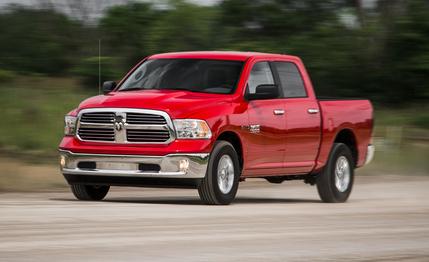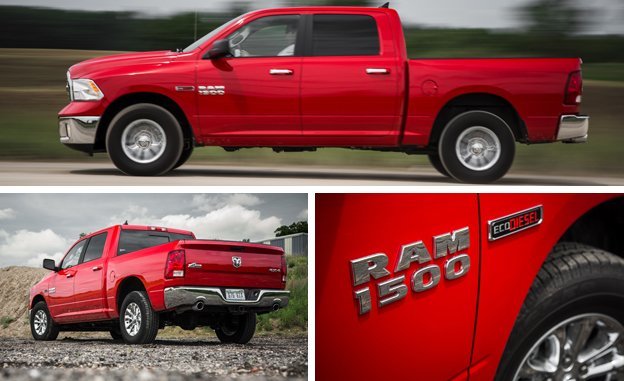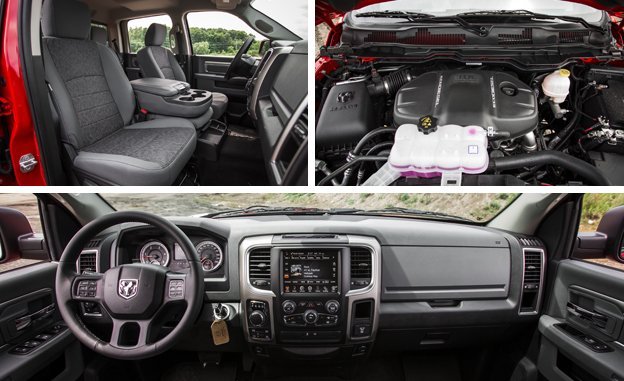
 Instrumented Test
Instrumented Test
Little has changed since we got our first shot at the Ram 1500 EcoDiesel: The Donald’s coiffure remains a triumph of applied engineering, artisanal toast inexplicably is still a thing, and Ram remains the only full-size, half-ton pickup to offer a diesel. Soon, however, there will be new competition, albeit indirect. Nissan’s 2016 Titan XD tweener is scheduled to hit showrooms later this year packing a Cummins diesel V-8, and GM’s slightly smaller Chevy Colorado/GMC Canyon twins are adding a diesel four-cylinder for 2016. For now, though, the Ram has the full-size, light-duty segment to itself.
Ram announced late last year that 20 percent of all 1500 pickup production capacity—fully twice the projected figure—was dedicated to the EcoDiesel, and it remains higher than 15 percent. That statement should come as little surprise, as diesels typically offer two things truck buyers covet: torque and efficiency.
As for the former, the Ram’s 3.0-liter turbocharged EcoDiesel V-6 cranks out 420 lb-ft at a relatively low 2000 rpm, ideal for doing truck stuff like towing, hauling, and crawling around in four-wheel-drive low-range while off-road. By comparison, Ram’s 3.6-liter Pentastar V-6 is rated at 269 lb-ft, the big-dog 5.7-liter Hemi at 410 lb-ft. Although the diesel’s 240 horsepower can’t match the 305- and 395-hp figures of the gasoline V-6 and Hemi V-8, you’d never know it based on around-town driving. The diesel’s low-end grunt makes quick work of motivating all 5688 pounds of a 19-foot-long Crew Cab 1500 like our test model.
Rated to tow an SAE J2807-certified 8560 pounds, the EcoDiesel bests an equivalent 1500 3.6-liter, which is rated for 7180 pounds. Option a Ram 1500 Crew Cab with the Hemi, however, and you can tow up to 10,150 pounds. (At that point, however, many shoppers with that much to lug might be tempted to just move up to a three-quarter- or one-ton diesel-powered machine like a Ram 3500, Ford Super Duty, or Chevy Silverado 3500 HD.)


While these numbers accurately reflect capability, it’s easy to lend too much credence to paper victories when comparing trucks. Based on our real-world experience, the EcoDiesel’s torque and its linear response make it a perfect partner for truck duty regardless of payload.
As for efficiency, the situation is a bit more complicated. Choosing the diesel option in the Ram 1500 will cost you $4960 over the base Hemi V-8 with a six-speed automatic, $4270 more than the V-6 with the eight-speed auto, and $3120 more than a Hemi with the eight-speed. For that sum, you not only get the 3.0-liter V-6 oil-burner, but also a 230-amp alternator, 800-amp battery, max-duty engine cooling, a 26-gallon fuel tank, and a 3.55:1 rear axle. The diesel also requires an upgrade to the 8HP70 eight-speed automatic, for $500. So you’re in for nearly $5K before you burn through your first tank of diesel fuel.
Our test truck came equipped with the provocatively named Big Horn package ($1205), which brings a Class IV trailer hitch, an electric-shift transfer case, fog lamps, bright exhaust tips, a power driver’s seat, a leather-wrapped steering wheel with audio controls, a folding rear seat, and a 115-volt AC outlet. Swapping in a 3.92:1 rear axle ($50) for the aforementioned 3.55:1 unit and adding front and rear rubber floor mats ($80) barely nicks the beer fund. Chrysler’s familiar Uconnect system ($1005) with the 8.4-inch screen and the usual complement of services (AM/FM/SiriusXM with Bluetooth, plus USB, SD, and auxiliary inputs) handles the infotainment chores. Our truck came with the 17-inch chrome wheel option instead of 20-inchers, triggering a $500 credit. In all, the extras added $6610, bringing the total price to $47,555.
With EPA ratings of 19 mpg city and 27 highway, the Ram 1500 EcoDiesel tops the 16/23 estimates for the V-6 1500 Crew Cab and the 15/21 numbers for the same truck with the 5.7-liter Hemi and eight-speed auto. In our hands, the EcoDiesel returned 21 mpg in combined driving. We did witness an indicated 29 mpg on long, flat stretches of expressway at 65 mph in neighboring states with notoriously stringent speed-enforcement policies. (Hello, Cleveland!) Conversely, we were a little more aggressive with the accelerator pedal around town than the average owner is likely to be. Even so, when considered against the 15 mpg we saw in our test of a 2013 Ram 1500 V-6 and the 17 mpg of our 40,000-mile, long-term Ram 1500 Crew Cab V-6, the EcoDiesel’s 22 mpg is an impressive number.


Somewhat less impressive is the zero-to-60-mph number, with the EcoDiesel taking 9.0 seconds, a full 1.2 longer than our departed long-term V-6 Ram. The quarter-mile measure fared similarly, the EcoDiesel’s 16.9-second time lagging slightly behind the long-termer’s 16.0-second run. Neither is going to win many races, but where the gasoline V-6 sometimes feels strained, the EcoDiesel just powers through, as if saying to the driver, “Yeah, what else ya got?”
The wild card here, of course, is the Ford F-150 3.5-liter EcoBoost. Not content to simply match the EcoDiesel’s 420 lb-ft of torque, the twin-turbo EcoBoost V-6 keeps 365 horsepower on tap, sufficient to knock out a 14.4-second quarter-mile time, as measured in our testing. At the same time, however, the Ford returned just 16 mpg in combined driving. Interestingly, despite an aluminum-intensive construction, the 2015 F-150 Crew Cab EcoBoost 4x4 we tested weighed in at 5577 pounds, just 111 pounds fewer than the Ram 1500 EcoDiesel.
It’ll take plenty of research to determine if dropping the extra coin on the Ram 1500 EcoDiesel will pencil in your favor. Your type of driving, payloads, trailering, annual mileage, and the cost of diesel in your area all will factor into the equation. However, no spreadsheet can illuminate how right the EcoDiesel feels from the driver’s seat.